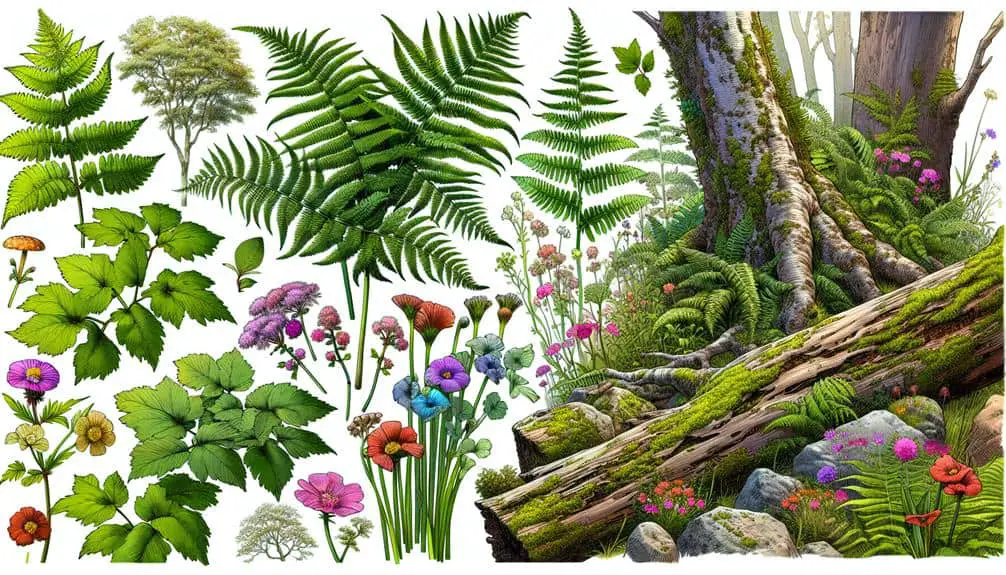On homeschool field trips, you can identify an array of plant life. Notice the wildflowers with their vivid colors and distinct shapes swaying in the breeze. Look closely at native trees, each with its exclusive bark patterns and leaf arrangements. Explore the plant families, recognizing their unique structures and habits. Discover the medicinal herbs and their healing properties. And be cautious of poisonous plants, like the infamous poison ivy. Keep exploring the diverse flora around you for an enriching learning experience.
Key Points
- Focus on flower characteristics like color, shape, and arrangement for identification.
- Recognize native trees by bark patterns, leaf shapes, and growth habits.
- Learn plant families through key characteristics like flower structure and growth habits.
- Study medicinal herbs for diverse properties and natural remedy benefits.
- Identify poisonous plants like poison ivy and safety precautions while exploring.
Types of Common Wildflowers
When exploring the outdoors on homeschool field trips, you can easily identify types of common wildflowers by observing their distinct characteristics and features. Wildflower photography and nature journaling serve as fantastic tools to document your discoveries. Engaging in a plant identification game or a scavenger hunt can make the learning process interactive and enjoyable.
To begin, focus on the flower's color, shape, and arrangement. Notice if the petals are fused or separate, the number of petals, and the overall shape of the flower. Pay attention to the leaves too; they can vary greatly between different wildflower species. Some may be broad and ovate, while others are narrow and lanceolate.
Additionally, take note of where the wildflower is growing. Is it in a sunny or shaded area? Is it near water? These environmental factors can provide clues about the type of wildflower you're observing.
Recognizing Native Trees
To accurately identify native trees during your homeschool field trips, focus on their distinctive bark patterns, leaf shapes, and growth habits. Understanding tree identification involves recognizing various leaf shapes and bark textures.
Native tree species often have unique characteristics that set them apart from non-native trees. When identifying trees by their leaves, notice if they're broad and flat like those of oak trees, or needle-like as seen in pine trees. Pay attention to the arrangement of leaves on the branches, whether they're opposite or alternate, as this can be a key identifier.
Examining bark textures is another essential aspect of tree identification. Some trees have smooth bark, like the American beech, while others, such as the shagbark hickory, have distinct, shaggy bark that peels away in strips.
Identifying Plant Families
Start by examining the key characteristics of plants, such as flower structure, leaf arrangement, and growth habits, to effectively identify plant families during your homeschool field trips. Utilizing plant identification techniques and understanding botanical classification will aid in this process. Plant family characteristics play an essential role in distinguishing one group of plants from another.
For instance, the Asteraceae family is known for its composite flowers, while the Lamiaceae family typically has square stems and opposite leaves.
When out in the field, having access to field guide resources can be immensely helpful. These guides provide detailed descriptions, illustrations, and keys to assist in identifying plant families accurately. By closely observing the plants' features and comparing them to the information in these resources, you can enhance your botanical knowledge and identification skills.
Learning About Medicinal Herbs
Exploring the world of medicinal herbs provides a fascinating insight into the diverse properties and uses of these natural remedies. Herbal remedy benefits are vast, ranging from soothing upset stomachs to promoting relaxation. Learning to identify these plants can be an enriching addition to any homeschool curriculum, offering both practical knowledge and a deeper connection to nature.
Medicinal plant uses vary widely, with each herb possessing unique qualities that make it suitable for different ailments. For example, chamomile is known for its calming effects, while Echinacea is often used to boost the immune system. By understanding the characteristics and benefits of these plants, you can harness their healing powers effectively.
Incorporating the study of medicinal herbs into your homeschooling can be a hands-on experience that engages all the senses. From cultivating your own herb garden to creating homemade remedies, the possibilities are endless. By immersing yourself in the world of herbal medicine, you not only expand your knowledge but also gain valuable skills that can benefit your health and well-being.
Spotting Poisonous Plants
Identifying poisonous plants is an essential skill when exploring the botanical world, especially after learning about the benefits of medicinal herbs. Poison ivy awareness is critical as it's one of the most common poisonous plants. Its leaves can cause a red, itchy rash upon contact. Understanding plant toxicity is key to staying safe on field trips.
To guarantee safety, it's important to take safety precautions such as wearing long sleeves and gloves when handling unfamiliar plants.
Plant identification plays a significant role in spotting poisonous plants. Look out for characteristics such as shiny leaves in groups of three for poison ivy. Learn to recognize plants like poison oak and poison sumac, which can also cause skin irritation.
Engaging in Eco-friendly Activities
As you set off on homeschool field trips to identify plants, engaging in eco-friendly activities is paramount.
By immersing yourself in the process of eco-friendly plant identification, you not only learn about the flora but also contribute positively to the environment.
These nature exploration opportunities offer rich outdoor learning experiences that foster a deeper connection with the natural world.
Eco-Friendly Plant Identification
Regularly practicing eco-friendly plant identification techniques during homeschool field trips enhances your understanding of local flora while fostering environmental stewardship.
Engaging in botanical scavenger hunts and plant ID games not only sharpens your plant identification skills but also instills a sense of curiosity and appreciation for the natural world around you.
By actively participating in nature journaling, you can document your plant discoveries, noting details like leaf shapes, flower colors, and growth patterns, which can deepen your botanical knowledge over time.
Additionally, incorporating plant crafts into your field trip activities allows you to interact with plant materials in a creative and sustainable way, fostering a deeper connection to the environment and promoting eco-conscious practices.
Nature Exploration Opportunities
Engage in hands-on nature exploration activities to deepen your understanding of local flora and enhance your connection to the environment during homeschool field trips. Nature scavenger hunts and plant identification games offer exciting opportunities to learn about different plant species while having fun outdoors. These activities challenge you to observe details like leaf shapes, flower colors, and growth patterns, honing your botanical knowledge.
Outdoor nature journaling is another enriching activity that allows you to record your observations, sketches, and thoughts about the plants you encounter. By documenting your findings in a journal, you create a personal botanical record that you can revisit and reflect on over time.
Additionally, botanical art projects provide a creative outlet to express your appreciation for nature through drawings, paintings, or pressed flowers.
Outdoor Learning Experiences
Engage in hands-on eco-friendly activities in outdoor settings to deepen your understanding of nature and foster a sustainable connection to the environment during homeschool field trips. Exploring the natural world through interactive experiences can enhance your appreciation for the intricate ecosystems surrounding you.
- Nature Scavenger Hunts: Begin exciting scavenger hunts to discover hidden treasures in the wilderness, encouraging you to observe and appreciate the biodiversity of the environment.
- Outdoor Sketching: Harness your creativity by sketching the beauty of nature around you, capturing the essence of plants and landscapes in your artwork.
- Plant Identification Games: Challenge yourself with fun games that test your knowledge of different plant species, allowing you to learn while having an enjoyable time outdoors.
- DIY Nature Journals: Create personalized nature journals to document your outdoor adventures, pressing plant specimens and jotting down your observations to create a lasting record of your experiences.
These activities not only make learning about nature exciting but also instill a sense of responsibility towards preserving our planet for future generations.
Frequently Asked Questions
Can We Bring Our Pets on the Field Trip?
You can't bring pets on the field trip due to pet restrictions. However, many locations are animal-friendly. Keep furry friends safe at home and explore the biodiversity of plants on your homeschool field trip instead.
Are There Restrooms Available Along the Trail?
As you wander the trail, like a curious explorer, remember trail etiquette. Restrooms are available at the trailhead. Bring water, as there are no water fountains along the path. Enjoy your adventure!
Is There a Gift Shop to Purchase Plant-Related Items?
Yes, there is a gift shop available where you can purchase plant-related items. The shop offers a variety of educational resources and tools to aid in plant identification. It's a great way to enhance your botanical knowledge.
Can We Have a Picnic During the Field Trip?
Yes, you can have a picnic during the field trip. It's a perfect opportunity to immerse yourself in nature, explore plant identification, and enjoy a meal surrounded by the beauty of the outdoors.
What Is the Best Time of Year to Visit for Plant Viewing?
Spring blooms offer vibrant colors and new growth, ideal for plant viewing. Fall foliage displays a kaleidoscope of changing leaves, showcasing nature's transformation. Both seasons provide rich opportunities to observe and identify various plant species.



